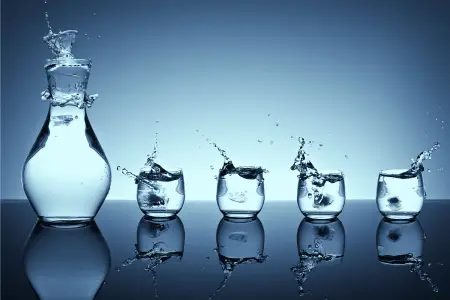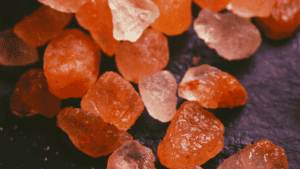Reverse osmosis filters do a great job at removing impurities from your water. Unfortunately, they they also remove the good minerals in water that we need for not only our health, but for the water to taste good.
This is where remineralization filters come in.
Remineralization filters do a great job in adding essential minerals like calcium and magnesium back into your water. They also improve the taste of reverse osmosis and distilled water that often tastes flat. RO water is also acidic, so remineralizing filters work well to increase the pH to a neutral level.
In this article, I will go over several remineralization methods to make your water healthy and delicious again after using a RO filter.
How to Remineralize RO Water
There are 4 main ways you can remineralize your RO water, depending on your situation. Some people prefer having an RO filter that remineralizes the water automatically, while others prefer adding Himalayan salt.
Whatever your preference is, here is an explanation of each option for remineralization.
Best Remineralization Filters
The best way to go when it comes to adding minerals back to your water is to start out with a reverse osmosis filter that has a post filter which remineralizes the water.
Post filters in RO systems will typically make your water alkaline, remineralize your water, and “polish” the flavor. Your post filters will need to be changed about every 6-12 months.
Many new filters are already set up with one, so if you are in the beginning stages of your search for the best remineralizing RO filter, then this is an essential feature.
Here are some of the best RO filters with a remineralizing filter pre-installed.
Countertop RO remineralizing filters
If you’re looking for a countertop reverse osmosis filter with remineralization, RKIN is the only brand we know of that does this. Not only does it remineralize the water, adding back magnesium and calcium, but it also alkalizes it.
- PUREST TASTING REVERSE OSMOSIS WATER: Zero Installation Purifier transforms...
- MODERN AND STYLISH COUNTERTOP WATER FILTRATION SYSTEM: Beautify any kitchen...
- SPACE-SAVING DESIGN: The supply water tank is conveniently located in front...
- BPA FREE. Removes up to 99% of all contaminants: Including Fluoride,...
- ZERO WATER WASTE: Easily accessible rejected water not suitable for...
Post Filters for Existing RO Systems
If you already have a RO filter but with no remineralization, then you can add a remineralization filter. These filters are easy to install and will fit with most systems.
But keep in mind post filters will vary in terms of what minerals they will add back (some will only add back calcium), and whether or not they alkalinize your water. If you’re looking for a filter that adds back magnesium, calcium, and also alkalizes your water, we recommend the Watts post filter.
Alkaline Water Pitchers for Remineralization
Alkaline water pitchers will add the necessary minerals back to the water and adjust the pH level.
Reverse osmosis water is slightly acidic and using an alkaline filter will change the pH by raising it slightly to a more neutral level. Water that hasn’t been purified is between 6 to 6.5 pH. An alkaline filter will usually bring the level up to 6.5 to 7 which is a big improvement to the acidic RO water.
There is nothing to set up. They take up very little counter space and the filter lasts longer than a post filter that remineralizes all the water coming through the filter even if you don’t plan to drink it.
The downside is that you are limiting how much water you have access to at any one time. If you are already used to using a water pitcher filter, then this shouldn’t be an issue for you.
Many of these filters work to remove many contaminants which may eliminate the need to even have a reverse osmosis filter, depending on your contaminants.
- FEATURES: large capacity, 10-cup pitcher, total filter content 3.5L, and...
- WATER FILTRATION FUNCTIONS: According to the source of water, 7-layer...
- ECONOMIC AND ENVIRONMENT-PROTECTIV: our filter can purify 300 16-ounce...
- DESIGN OF THE PURIFIER: Oval outline that is simple and elegant, easily fit...
- HEALTH & SATISFACTION: Exquisite package, an ideal choice as a gift for...
- ✅ MILLIONS OF AMERICANS DRINK CONTAMINATED WATER EVERY DAY - These...
- ✅ ENHANCES pH UP TO 9.5 - This hydration helps flush harmful toxins from...
- ✅ BETTER TASTING WATER AND BEVERAGES - Taste the difference in your...
- ✅ SIGNIFICANT COST SAVINGS - While another type of alkaline water machine...
- ✅ FILTERS PROUDLY MADE IN USA - Beware of other water filter companies...
Mineral Drops for RO Water
The fastest way to remineralize your water is by adding trace mineral drops. Remineralization drops are full of electrolytes so they add a ton of benefits.
Besides calcium and magnesium, you’ll also be adding sodium, potassium and lithium. It is like having some Gatorade but without the sugar and excess salt.
These drops also aid in hydrating the body better by improving your gut health. If you are using a water distiller machine, then these drops are essential as the distilled water is far too pure to be healthy to drink. Distilled water is not meant to be consumed, and remineralizing distilled water is advised.
These are our top recommendations for remineralization drops for RO water and distilled water.
Remineralize Water with Himalayan Salt
Himalayan pink salt contains 84 trace elements so it can make your water better even if you aren’t using a reverse osmosis filter or distillation machine. This is a very efficient way to remineralize your water.
One thing to note is that it is a sea salt from a deposit from hundreds of millions of years ago. So, any sea salt will work here. If you don’t want to spend so much then try a cheaper, unrefined sea salt that is within your budget and you will get the same benefits.
About a quarter teaspoon per gallon of water should be enough to get those minerals into your water without leaving it taste too salty. You can adjust the levels yourself according to your taste. One thing to remember is that it is recommended to not go over 2,500 grams of salt per day from all of your sources. Best to keep the dosage low when remineralizing with sea salts.
Make sure to let the water sit and then stir or shake it frequently to make sure the salt is totally dissolved to get the full benefits. Fine sea salt works best for this.
Do You Need to Remineralize Water from an RO System?
No, you really don’t need to remineralize your water. Remineralizing is a good idea even though it isn’t strictly necessary.
The thinking is that reverse osmosis water is unhealthy to drink. The reality is that many people in industrialized countries get more than enough necessary minerals from their diet.
Even though the minerals in water that RO filters remove are necessary, you generally are going to get them from other sources and not suffer any health issues.
One thing to note, however is that when you boil food in RO water, much of the calcium and magnesium present will leach out so if you don’t consume the cooking liquid, then you will lose some of the minerals from the food when you eat it.
Taste is another matter altogether, however. Many people with reverse osmosis filters report their water not tasting right. This is because minerals like calcium and magnesium give water the flavor we are used to. When they are removed it just tastes flat.
Making coffee and tea with reverse osmosis filtered water is also a disappointment. Usually, it turns the coffee bitter and not very pleasant to drink. This alone is a reason for me to want to remineralize the water!
What Minerals does Reverse Osmosis Remove?
Reverse osmosis removes magnesium, salt, iron, manganese and calcium. When cooking is done with demineralized water, your food loses essential minerals, about 60% of manganese and calcium and 70% of manganese.
Luckily, reverse osmosis doesn’t remove the following:
Reverse osmosis is the most effective type of water filter on the market. It works by forcing water through a series of increasingly finer filters to the point that the finest is almost like passing water through plastic film. Almost everything in the water is removed and pure water comes out the other side.
All the minerals in the water are removed. This is good since you don’t want things like lead, other heavy metals, bacteria, cysts, arsenic, fluoride, cadmium and cyanide among many others.
But the problem is that it also removes things like potassium, magnesium and calcium which our body needs.
Though it should be noted that when you have hard water, those minerals can damage appliances and pipes. It makes sense to use a reverse osmosis filter if that is the case and then remineralize your water as a way to protect your washing machine, dishwasher and even your pots and pans.
Is Remineralized Water Good for You?
There is nothing unhealthy about drinking remineralized water with one word of caution, however. You can end up getting too much salt in your diet depending on how you remineralize your water.
Drinking RO or distilled water is too pure and contains no minerals at all. There are 21 minerals that we need to survive so adding minerals back to your water is a natural and healthy thing to do.
Since RO water will pull some of the minerals out of foods that you cook in it, it does make sense to add more minerals back to the water, so yes, the answer is that remineralized water is good for you.
If you are in any doubt about whether your diet will provide enough minerals when you drink RO water, then your best bet is to try to add more by any of the above means.
Does RO Water Leach Minerals from the Body?
There is no evidence that reverse osmosis water will end up leaching minerals out of your body when you drink it for long periods.
What is apparent, however, is that food cooked in soft water in general will leach calcium and minerals out of it. If you are making soup and drinking the broth you will end up consuming those minerals.
If you are boiling vegetables to eat without the cooking liquid, then they will have fewer minerals and may result in a poor diet which will mean that you have to replace those minerals in your water.
How do I Test my Reverse Osmosis Water?
Testing your water both before and after your water has been filtered is easy and cheap.
All you need is to use an at home test from Amazon that can tell you in a matter of minutes what may be lurking in your water. These tests can range from just a few contaminants to dozens that may be present in your water.
Since you are looking specifically at what minerals there are present, I recommend a hardness test. What you are looking for is to check the TDS (Total Dissolved Solids) present in the water.
To get accurate results a TDS digital water test is the way to go. There are test strips, but you can’t get a good idea of how much of a contaminant there is when it tests positive.
It’s also a good idea to test the pH of your water in addition so you know if your water is too acidic after filtering with a reverse osmosis filter. You should also check the pH after remineralization to make sure that the water isn’t too alkaline, too.
This meter below has both kinds that test TDS and pH so you are covered either way.
Remineralized Water vs Alkaline Water
Drinking alkaline water, or high pH, does not give you any health benefits on its own contrary to some claims.
What is a benefit is that when you remineralize your water, primarily if you add calcite, then the pH will naturally rise and the water will be less acidic. Acidic water is not bad or good for you unless it is very acidic. RO water is not so acidic to be a problem in most cases.
Alternatively, water with too high a pH could be bad for you so you have to be careful about how much you alter the pH by adding minerals back.
FAQ About Remineralizing Water
The only time it is explicitly unhealthy to drink reverse osmosis water is if you live in a country or area with limited access to healthy foods. If your diet is poor in calcium and magnesium and you drink RO water then you will have health problems.
People living in industrialized countries with a wide variety of fruits, vegetables and meats in their diet won’t have any health problems due to drinking it.
Coffee brewed with distilled or even RO water will be bitter and taste really bad. If you plan to make coffee with purified water, make sure to remineralize it first.
Your water may still have traces of pesticides, herbicides and fungicides. There may even be some chlorine left depending on how high the concentration was before it was filtered.
If you are reading this, you probably live in a first world country where you get more than enough minerals naturally from your diet. So on the mineral front, you are probably OK.
However, keep in mind that RO water is more acidic. While still in the pH range of healthy drinking water, those with pre-existing conditions like acid reflux might want to consider a remineralizing filter to raise your waters pH.
Remineralization cartridges will generally last about 6-12 months before they need to be replaced.
Bottom Line
There is a lot to be written about reverse osmosis and remineralization that could fill a book. It is not as simple as is it good or bad. There are varying levels of complication that depend highly on several factors.
I think that for most people it is not 100% necessary to remineralize water from a health perspective. But at the same time, organizations like the WHO have already written about the dangers of demineralized water.
I think that it pays to hedge your bets and remineralize just in case.
The other issue is the taste of the water. RO water tastes insipid and flat. Remineralized water simply tastes better.

Nick Lopresti is the founder of YourH2Home and a home improvement expert. He has years of experience writing about various home improvement topics, mostly as it pertains to water systems.













